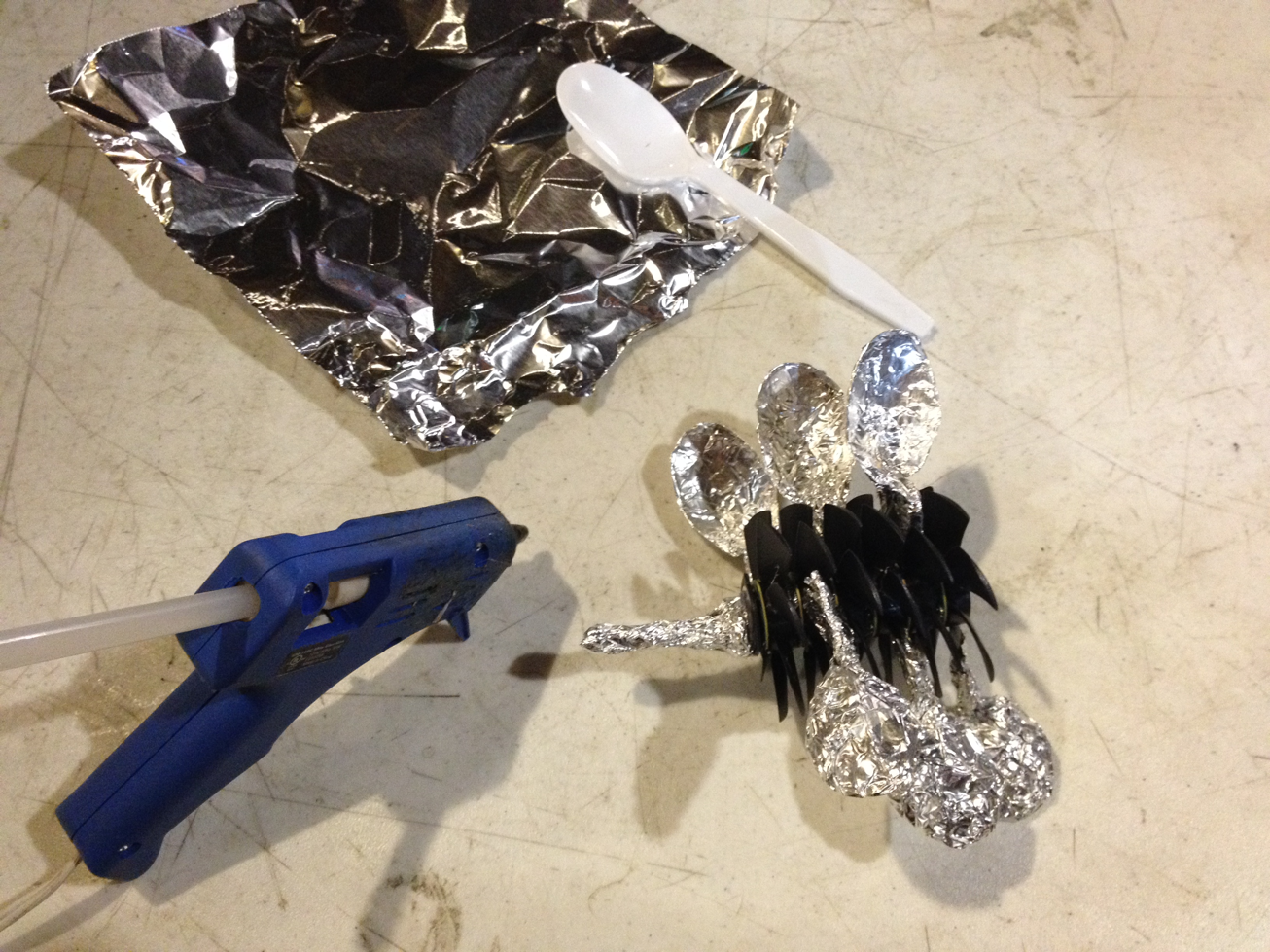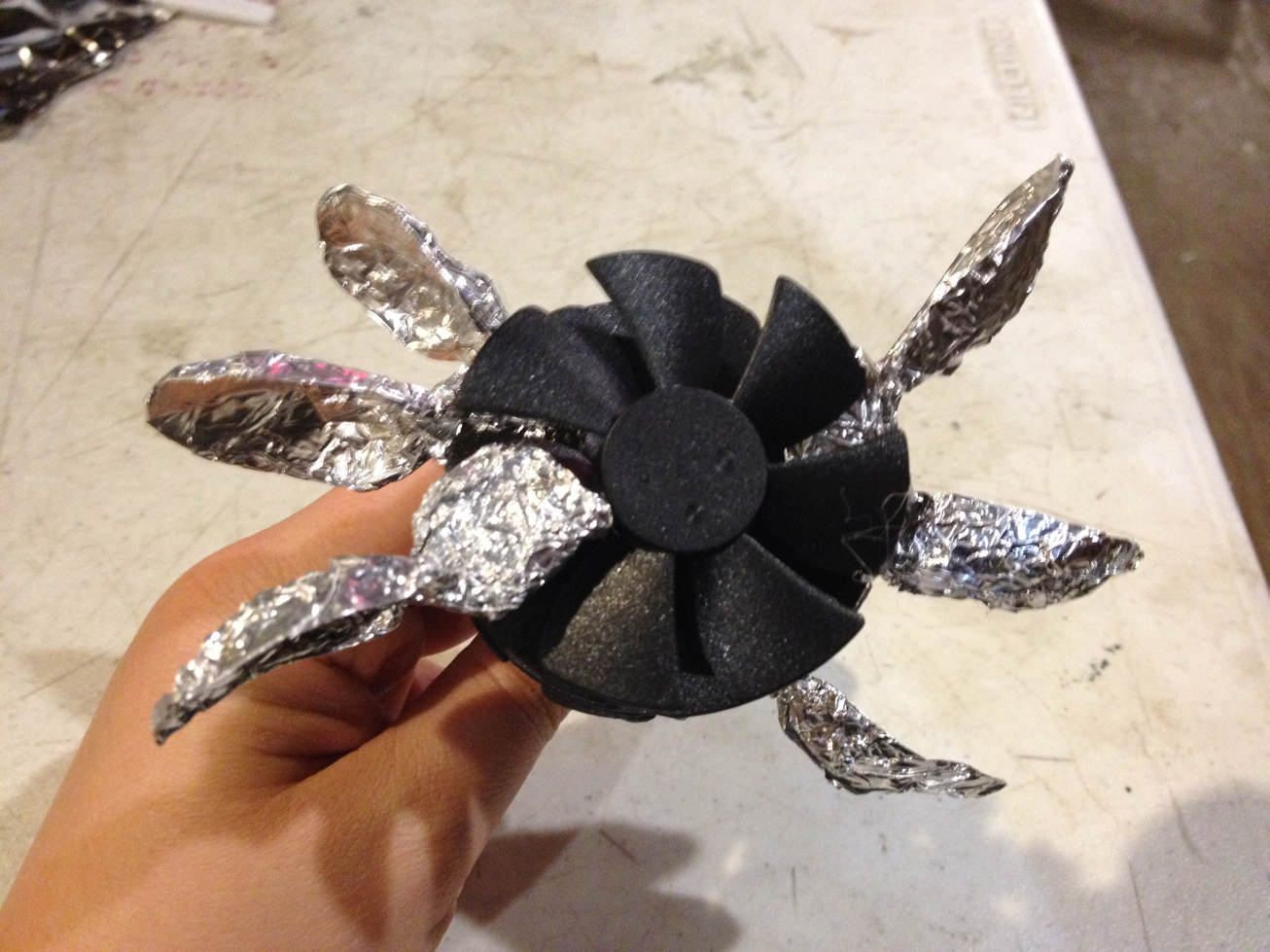a sinuous kinetic sculpture
To make the experience fit your profile, pick a username and tell us what interests you.
We found and based on your interests.
At LVL1 tonight. Shared videos of several different kinds of kinetic sculptures with Jose, and discussed ideas for what shape I might like the project to take. I like the idea of a living creature--maybe a manta ray, with its wing-like undulation, or a dragonfly, with its flapping wings and segmented body.
Went down to the boneyard to look for parts that might spark an idea. There are tons of computer fans down there, including several of these:

I pulled the fans out of two of them, removed their frames, and hot glued them together so that they would spin independently on the same axis. Then, using a spoon, I shaped aluminum foil into 6 cups and wrapped them around blades on both fans. I tilted the cups away from each other so they wouldn't hit the ones on each other's blades as they moved by each other. Gentle blowing on them caused them to spin smoothly.
From watching videos, I knew I would need to attach the pieces to each other, so I hot glued two blades together, offsetting the fan blades. This allowed them to spin together. I then removed the foil, pulled out four more fans, and glued them to the others. I shaped a handle and glued it to the end of the stack. Then I reattached the foil cups, one to each fan, alternating placement as I went.


The six cups are still enough to move the entire assembly by blowing on them. I ran out of time to make more foil cups, but will return to the project later.
I've been watching videos of different kinds of kinetic sculptures. I continue to be amazed at how a collection of hard pieces can make soft, flowing motion. The movement requires interdependence of the pieces, and their solidity allows force to transfer between them efficiently.
Where will the force originate? Is it electrical? Or powered by wind? Does the piece need to be touched to move?
Seeing interviews with the artists is both encouraging (these things were all designed and created by real people) and discouraging (they have education, experience, skills, and resources I lack). Many of them use computers to design their works, which intimidates me. 3-D modeling software has a steep learning curve, and the few times I've tried using such programs have been incredibly frustrating for me.
I'm fascinated by frustration. It has such a strong effect on people. When it stems from not knowing how to do something, it can be hard to distinguish whether the skill is within my zone of proximal development (and would be worth pursuing) or is beyond what I'll be able to accomplish.
In this case, the idea of using design software is so daunting that when I come across it in these videos, it makes me want to give up on the idea of doing this at all. I have to keep talking myself back into it.
Overcoming my brain's drive to avoid frustration may be the most challenging part of this project.
How did I come up with the idea to do a kinetic sculpture?
I went to LVL1 last night to finish documenting Alien Operation. I can't be there for long without getting interested in the projects other people are working on. Joseph Clagg was talking to Jose Cabrera about making a life-size version of Rock Em Sock Em Robots. Boxing isn't my thing, I said, but Hungry Hungry Hippos was a game that, although I never played, seemed like something I'd enjoy. That piqued their interest. Later I suggested that not all of the players had to be hippos: there could be a dragon, for example, and an alien, with a smaller alien head inside that would come out to eat the marbles.
In thinking about creating something moveable that had an extra layer of complexity to it, I realized I'd prefer to do it as an original project.
I've been interested in gait and locomotion ever since, when I was much younger, I tried to find a word to describe the undulating gait of a spider. I thought about it again recently when I saw a video of a two-legged dog playing at the beach, and how its tail was so crucial not just as a balance and counterweight, but also as a pivot point or rudder at times. It made me wonder what advances have been made in robotic locomotion, which has typically been stiff and unnatural.
Then I remembered the phrase "kinetic sculpture".
I was able to find the video that introduced me to the concept years ago, and to find other inspirational examples. Although I looked through many videos, the ones that drew me most had curving lines and organic motion. Links to my favorites are on the project page.
Now I'm thinking about the components of the sculptures I've looked at and about what feel I'd like to achieve with a project of my own.
Create an account to leave a comment. Already have an account? Log In.
Become a member to follow this project and never miss any updates